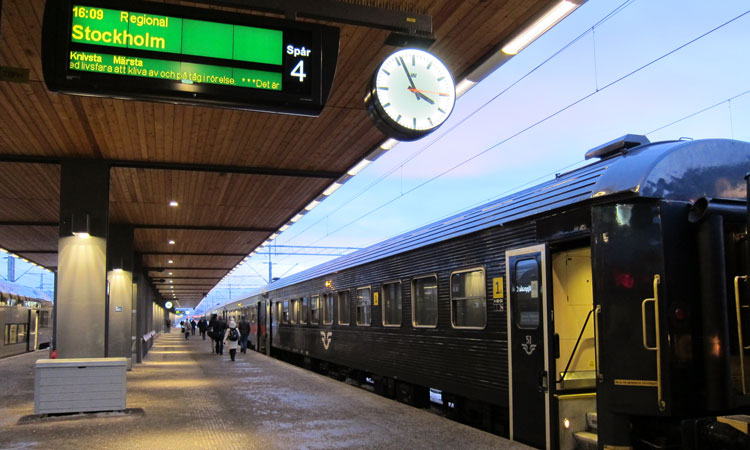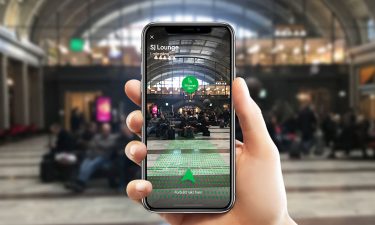Collaborating with staff and passengers to be digital number one
Posted: 5 December 2019 | Claes Lindholtz | No comments yet
With SJ aiming to be the number one digital company in Sweden, we spoke to Claes Lindholtz, Head of Digital Transformation at SJ about what digital initiatives the operator is conducting to reach this goal and how it encourages its staff and passengers to aid it on its digital journey.


Credit: SJ
The CEO of SJ AB, the government-owned passenger train operator in Sweden, has stated that he wants the operator to be the number one digital company in the country. As head of the team in charge of delivering this initiative, we ask Claes Lindholtz more about this journey to be number one.
“Digitalisation is an enabler of a core strategy,” Claes told us. “Our CEO made a bold statement and said: ‘Within five years, we need to be the most digital company in Sweden’. That’s any industry. Better than Ikea. Better than Spotify. Everybody. And I got the opportunity to lead it and we have a core team of about six people.”
“We decided two years ago to put a group-wide initiative into place to make the most out of digitalisation, because, as a company, we are really digital. We were back then and we are now. We have 97 per cent online ticket sales and I think more than 50 per cent of passengers buy their tickets on their phone through the app, as well as on our website. We don’t even have tickets anymore. Well, you can print them yourself at home, but that’s about it. So we’ve done a lot, but we need to do more.”
‘To be the number one digital company in Sweden’ truly is a bold statement. But digitalisation can mean varying things, from passenger-centric digital initiatives to improving and maintaining operations as well as in-house digital improvements.
“I think the statement was more of a ‘let’s put a man on the moon’ message to inspire people, which it has,” Claes said. “It’s really inspired our own staff, but it’s more about what we need to do to become number one. So I think that what we’re hoping for is to have the happiest employees and the happiest customers at the lowest cost. So, being number one digital measurement-wise isn’t that important. It’s more of an inspirational standpoint, I would say.”
What we’re hoping for is to have the happiest employees and the happiest customers at the lowest cost.”
“We’ve scoped up the roadmap for the next five years to achieve this, because it’s a huge task and you can’t do everything at once. And so we have three waves: Wave number one is operational efficiency, so we’re making sure we have all the groundwork done before we start the next phase. This means making sure that we have all the infrastructure in place. We’ve talked about having sensors on trains and big data platforms and so on, so we have the right processes. We also want to make sure all employees have the right tools; that we have gathered the data correctly so we can use it across the processes.”
“Wave number two (which is scheduled to begin in 2021), is the next generation of customer touchpoints, and the third wave is whole new business models – but all based on data brought in during waves number one and two. The idea is to be able to attract and collect so much data that we can build the customer touchpoints in wave two, and then we get even more data that we can use for the new business models for wave three. So, each wave builds upon the next.”
Being digital is about the people, not technology
SJ has many digital initiatives, such as having more simple and flexible tools for buying tickets and getting relevant information about customer journeys on a smartphone or mobile device, as well as 3D printing of spare parts, generating and collecting data with the help of sensors from the train and VR-based personnel training.


SJ is investing in virtual reality in education. Credit: SJ
“I think VR is particularly amazing,” Claes enthused. “For us, digitalisation is about people and not technology. If we don’t get people to change the way they work and see how they can utilise technology to be more effective, then it won’t benefit anyone.”
“This is why we are engaging our staff in multiple ways. We use a pretty much bottom-up approach to our staff, and we tend to find that the best ideas come from the working force. Our job is not to come up with the ideas. Our job is to empower people so their ideas can be realised.”
“So, with virtual reality training, that idea came from the staff. Two and a half thousand people, pretty much all the workforce in SJ, are now being trained in virtual reality.”
“We’ve built Virtual Reality Centres in 14 locations around Sweden. So, instead of going to a central facility, our staff can go somewhere locally in their own time. The training also has inbuilt gamification, and people are loving it. People are staying in the evening to train and even putting up scoreboards. We didn’t build scoreboards because we thought that might not be attractive, but people are putting signs up on the walls themselves.”
“There are many new emerging technologies that are changing the world, like VR, AR, IoT, drones and robots. So, we teach them everything about that and how it works, and they get to try it. Then, we tell them: ‘If you had all the data available and all this technology available, how would you go about doing your job?’ And they come up with hundreds of ideas which we take and build upon.”
Involving passengers on the digital journey
Many of SJ’s digital initiatives are customer-centric, with a roll-out of several projects released over the past couple of years that are designed to improve passenger experience, such as the Swish mobile payments for customers to buy tickets via SJ’s digital channels, the microchip implant ticketing and the launch of ‘The Great Sign Hunt’, a contest to help develop a new feature in SJ’s mobile app that will assist train passengers in finding the right spot on the platform.


Many of SJ’s new digital initiatives focus on improving passenger experience. Credit: SJ
“Our customers love our digital initiatives,” Claes said. “We’ve created something called SJ Labs, which is an innovation hub where we invite the customers into our processes of development. We co-create new ideas with customers, and the customers can try new services and give feedback. So it’s a process we go through together with the customers.”
“For example, we built a way for our customers to know where they should stand on the platform when boarding a train. It’s a common problem; you’re on the platform, and you want to stand near a door when the train arrives. And we thought: how can we help our customers make sure that they stand in position? But the platforms are a governmental agency. We only drive the trains, we have nothing to do with platforms or signs. However, everyone has a smartphone in their pocket and we realised we could utilise that. So, one of my colleagues went to a hardware store, bought a laser measurement system for playing golf and went to a train station because there are no maps of the platforms that we know of.
“We measured everything ourselves and built an app where, since we know where the train stops, we could utilise the GPS signal in our customers’ phone to tell them the section where they should stand on the platform.”
“We built that, and our customers loved it. They started having a competition to see who could be the best on the platform for standing close to the door and gave us a lot of feedback.”
“It worked so well that we needed to scale the project up – we couldn’t have my colleague going to all 300 stations and measuring them with his laser! So, we made a game of it. We asked customers to take pictures while at a platform. They took pictures, sent them to us and we used machine learning to build a digital twin of every platform in Sweden. We couldn’t have done it without our customers. They loved it and we got the information we needed. That only took six weeks. And then we built it.”
“It has helped with passenger flows and, by making sure that people are standing where they should stand, they also get on and off at the right time. Thus enhancing punctuality.”
“It’s win-win. It’s better for our customers and it’s better for us.”
Data is not the new oil… it’s the new uranium
Collecting data is an integral aspect when discussing digitalisation, but equally as important is storing data, keeping that data safe and then utilising it to reach that crucial next step in digitalisation.
“Everybody keeps talking about data being the new oil. But I heard something even better the other day – that data is the new uranium. It’s even more precious and you have to think about it,” Claes said. “How do you store it long-term? Short-term? How do you make the most of it? What about integrity, and so on? When you look at customer data, you have to be really careful so it doesn’t leak.”
“It can be relevant for so many aspects of the rail system. For example, we could put sensors in the toilet to see if someone’s in there. Then you could use it to show our customers which toilets are free. We could tell the on-board staff that a particular toilet has been used a lot. We could also use that data for the depot to tell them that, say, the toilets in wagon three, seven, eight need extra cleaning because they have been used most. So we will be using the data all across the company.”
“I think data is at the core of this organisation. We are truly data-driven in everything that we do and we ensure that we utilise the data to be more relevant and personalised to our customers.”


There are many possibilities of data to improve passenger experience and operations. Credit: SJ
“There are so many possibilities with data. Imagine if the air conditioner breaks, the sensors will immediately notify on-board staff that it’s not working and that in carriage number two, for instance, we currently have 47 passengers who may get too warm because the conditioner’s broken down. Then, at the same time, those sensors will send a message to those passengers in the carriage to notify them. It can then get in contact in with the catering cart: ‘Do we have coffee and buns? Yeah we do.’ So those customers that have been affected by the malfunction will get a notification on their phones saying that they have a voucher for free coffee and buns. Equally, at the same time, that message goes to the depot warning them that a train will be coming in with this part broken, so we need to 3D print that part to change it.”
The two axis of digitalisation
Digitalisation is a complex and broad topic, with various moving aspects that involve both the passengers and staff, and will greatly affect many aspects throughout the railway system and the company itself. How does Claes envision accomplishing this huge task of completing SJ’s digital transformation?
If you give the people the tools and the knowledge and capabilities, you can get to where you want to be.”
“We’re going to do this transformation in two axis. One axis is like building anything that needs to be built, like data, cloud platforms, sensors, apps, and so on. The other axis is changing the way we behave. An analogy would be to imagine that you’re walking and you say ‘I want to move faster’. A bicycle seems like a good idea because it’s so much faster than walking. So, the one axis is building the bike and the second axis is learning how to ride the bike. Because, if you only build the bike, you have to keep dragging it next to you. You’ve spent lots of money, but you’re moving even slower than before because you’re just dragging a bike around with you. But, if you build the bike and learn to ride, then you can really accelerate. And I think the same way about digitalisation. If you give people the tools, the knowledge and capabilities, you can get to where you want to be.”
“We started this journey because we saw that, in general, people are more digital. We don’t see digital as ‘something else’. It’s at the core of everything. It’s part of everything. Our hope and belief is to have digitalisation at the core of everything we do at SJ. So, eventually, we won’t need a digital department, we won’t need a chief digital officer or any roles like that.”
“So, strange though it may seem, as a digital department, our aim is to make sure that we are not actually needed. That is the end goal.”
Related topics
3D Printing/Additive Manufacturing, Artificial Intelligence (AI), Big Data, Digital Twins, Digitalisation, Infrastructure Developments, Operational Performance, Passenger Experience/Satisfaction, Passenger Information Systems (PIS), Rail Fares/Ticket Pricing, Real-Time Passenger Information (RTPI), Smart/Contactless Ticketing, Station Developments, Technology & Software, The Workforce, Training & Development, Virtual Reality (VR)








